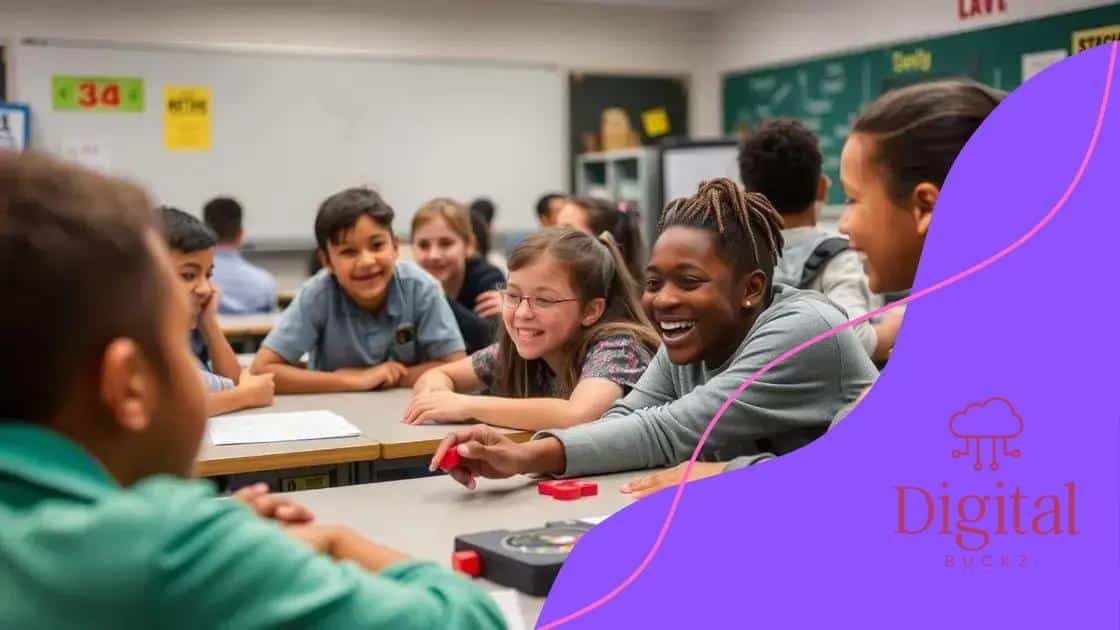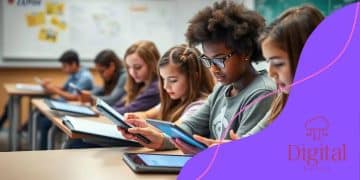The role of gamification in motivating students

The role of gamification in motivating students significantly enhances engagement and learning outcomes by incorporating game elements that foster active participation and collaboration, while addressing diverse learning needs.
The role of gamification in motivating students is more significant than ever in today’s digital age. Have you ever wondered why game mechanics can ignite a spark in learning? Let’s delve into this fascinating topic.
Understanding gamification and its principles
Understanding gamification and its principles is crucial for integrating this approach into educational settings. At its core, gamification involves applying game-design elements in non-game contexts to boost engagement and motivation. Have you ever noticed how a simple game can capture your attention for hours? That’s the power of gamification.
Key Principles of Gamification
There are several fundamental principles that guide successful gamification strategies. These principles help in crafting effective experiences that resonate with learners.
- Feedback: Instant feedback is essential for guiding students. When they make progress, it encourages them to keep trying.
- Rewards: Offering rewards for achievements can enhance motivation, providing tangible benefits for their efforts.
- Progression: Clearly defined levels or stages help students see their advancement, making the learning pathway visible and achievable.
- Community: Building a sense of community through teamwork can create a more enriching educational experience.
While implementing these principles, it’s vital to understand the audience. Are they motivated by competition? Do they enjoy collaboration? Tailoring the approach to fit the students’ preferences can lead to a more successful gamification experience.
Additionally, gamification can spark curiosity and inspire students to take control of their learning. Rather than solely relying on traditional teaching methods, leveraging game mechanics can create an environment where students are excited to participate actively. When they feel ownership over their learning, the results can be remarkable.
Incorporating storytelling elements within gamification can also enhance the experience. By setting up engaging narratives, students can connect with the material on a deeper level. The more relatable the story, the more they will engage with the content. So, how can teachers weave these principles into their curricula? Exploring different game mechanics can be a terrific start. Simple challenges, point systems, or cooperative tasks can all be integrated into lessons.
How gamification boosts student engagement
How gamification boosts student engagement is a vital topic in modern education. By utilizing game mechanics in learning, teachers can create a more stimulating environment. Have you ever watched students who are actively playing a game? Their focus and excitement are remarkable, and this is what gamification aims to replicate in educational settings.
Creating Exciting Challenges
One significant way gamification enhances engagement is by offering challenges that are fun and interactive. When students work towards completing levels or achieving badges, they experience a sense of accomplishment. This element of play can make subjects more interesting and motivate students to participate.
- Interactive Quests: Quests can lead students on a journey to achieve goals, making learning feel like an adventure.
- Competition: Healthy competition among students can drive them to do their best and strive for improvement.
- Immediate Feedback: Providing instant responses can help students correct mistakes and learn faster.
- Progress Tracking: Students can visualize their growth through charts or progress bars, increasing their motivation to keep going.
Additionally, gamification fosters collaboration. Group activities that incorporate game elements encourage teamwork. When students collaborate to achieve common goals, they develop essential social skills while also learning academic concepts. This peer interaction makes the learning process more dynamic and enjoyable.
Moreover, incorporating stories into the gameplay can further increase student engagement. When students feel emotionally connected to the material through a narrative, they are more likely to pay attention and retain information. As they navigate through challenges, the stories help ground their learning in real-world contexts, making lessons relevant and memorable.
A key aspect of gamification is that it can cater to different learning styles. Whether students are visual learners, auditory learners, or kinesthetic learners, a well-designed gamified environment can address these diverse needs. This adaptability ensures that every student can benefit from engaging educational experiences.
Real-world applications of gamification in education

Real-world applications of gamification in education show how this concept can transform classrooms and enhance student experiences. Various educational institutions have successfully integrated game mechanics into their curricula. By doing so, they have made learning relevant and exciting.
Case Studies of Gamification
One notable example is the use of gamification in language learning programs. Apps like Duolingo have employed game-like features to keep users engaged. Learners earn points and rewards for completing exercises, which encourages them to continue practicing daily.
- Progress Tracking: Users can visualize their learning journey through levels and accomplishments.
- Daily Challenges: Creating a habit of practice, users are encouraged to meet daily goals.
- Peer Competition: Leaderboards introduce a fun competitive element, motivating students to challenge their friends.
Another effective application is seen in classrooms that utilize gamification for science education. In some schools, students engage in virtual science labs where they conduct experiments through games. This hands-on approach not only boosts engagement but also deepens understanding of complex concepts.
In addition to apps and virtual labs, traditional classrooms also benefit from gamification. Teachers can turn quizzes into interactive games, such as Jeopardy or trivia competitions. This format not only makes reviews entertaining but also encourages participation from all students.
Benefits of Real-World Applications
Implementing gamification strategies in real-world settings offers numerous benefits. For one, students tend to show improved motivation and engagement. They feel a sense of ownership over their learning, making them more likely to participate actively.
- Enhanced Learning Retention: By making lessons more interactive, knowledge retention improves.
- Increased Collaboration: Group challenges encourage teamwork, fostering important social skills.
- Personalized Learning: Students can progress at their own pace, adjusting the difficulty according to their comfort level.
Moreover, data collected from gamified activities can help educators understand student performance better. Teachers can identify areas where students struggle and tailor their instruction accordingly. This data-driven approach leads to more effective teaching methods and improved student outcomes.
Enhancing learning outcomes through gamification
Enhancing learning outcomes through gamification is an innovative approach that many educators are embracing. By integrating game-like elements into the curriculum, teachers can create an engaging environment that boosts comprehension and retention. This technique not only makes learning more enjoyable, but it also leads to better academic results.
How Gamification Affects Learning
The impact of gamification on learning outcomes can be profound. When students participate in gamified activities, they often become more motivated. A sense of achievement comes from completing tasks and earning rewards. This intrinsic motivation encourages them to invest more time and effort in their studies.
- Active Participation: Gamification prompts students to be active participants in their learning rather than passive recipients of information.
- Critical Thinking: Challenges and puzzles stimulate critical thinking as students work to solve problems.
- Retention Rates: Engaging content can lead to higher retention rates, making information easier to remember.
Additionally, gamification can accommodate various learning styles. By presenting information in different formats, such as visuals, audio, and interactive tasks, all students can find a way to engage with the material that works best for them. This inclusive approach ensures that no student feels left out.
Another important aspect of gamification is that it can foster a sense of community among students. When they work together towards common goals, they learn valuable collaboration skills. Group challenges and team-based activities promote teamwork, which is essential for future success.
Real-Time Feedback and Progress Tracking
Instant feedback is one of the greatest benefits that gamification offers. Students receive immediate responses to their efforts, allowing them to understand their mistakes and make adjustments quickly. This real-time feedback is crucial for improving their skills.
- Adaptive Learning: Based on feedback, teachers can adapt instruction to meet students’ needs.
- Gamified Assessments: Instead of traditional tests, gamified assessments can provide a more accurate measure of understanding.
- Progress Indicators: Students can track their progress through levels or points, motivating them to continue improving.
Overall, through various gamified strategies, educators can create powerful learning experiences that resonate with students. By embracing gamification, teachers can significantly enhance learning outcomes and prepare students for success in their educational journey.
Challenges of implementing gamification in classrooms
Challenges of implementing gamification in classrooms can create obstacles for educators. Despite the benefits, several factors need careful consideration to make this approach effective. Understanding these challenges is the first step in overcoming them.
Resource Availability
One significant challenge is the availability of resources. Schools may not have access to technology or materials necessary to create a gamified environment. Without proper tools, it becomes difficult for teachers to implement engaging activities that utilize game mechanics.
- Budget Constraints: Many schools operate under tight budgets, limiting their ability to invest in new technology.
- Teacher Training: Educators may lack the training needed to effectively integrate gamification into their teaching methods.
- Infrastructure Issues: Limited internet access or inadequate equipment can hinder the adoption of digital gamification tools.
Another challenge arises from the diversity of student needs. Classrooms often include students with varying abilities and learning styles. Designing a gamified experience that engages all students can be complex. Educators must create activities that support both advanced learners and those who may struggle with certain concepts.
Balancing Fun and Learning
Finding the right balance between fun and educational value can also present difficulties. If students focus too much on the game elements, they might lose sight of the learning goals. It is crucial to ensure that gamification enhances understanding rather than distracts from it.
- Clear Objectives: Educators should define clear educational objectives so that students understand what they are supposed to learn.
- Monitoring Progress: Teachers need to monitor student engagement and achievement regularly to adjust activities as necessary.
- Feedback Mechanisms: Incorporating consistent feedback helps students stay focused on their learning goals.
Inexperienced implementation can lead to disruptions in the classroom. If students feel overwhelmed by new rules or complex mechanics, it can diminish their excitement. Gradual introductions to gamification are essential to avoid overwhelming the learners.
Ultimately, overcoming these challenges requires thoughtful planning and support from school administration. By addressing these issues strategically, educators can harness the full potential of gamification to create enriching learning experiences.
FAQ – Questions about Gamification in Education
How does gamification enhance student engagement?
Gamification makes learning fun by incorporating game-like elements, which motivates students to participate actively in their education.
What resources are needed to implement gamification?
Implementing gamification may require technology, training for teachers, and creative materials to engage students effectively.
How can diverse learning styles be accommodated in gamified environments?
Gamified activities can be designed to include various formats, such as visual aids, interactive tasks, and collaborative projects, catering to different learning preferences.
What are the main challenges of using gamification in classrooms?
Challenges include resource limitations, ensuring the balance between fun and learning, and addressing the diverse needs of students to create an inclusive experience.






